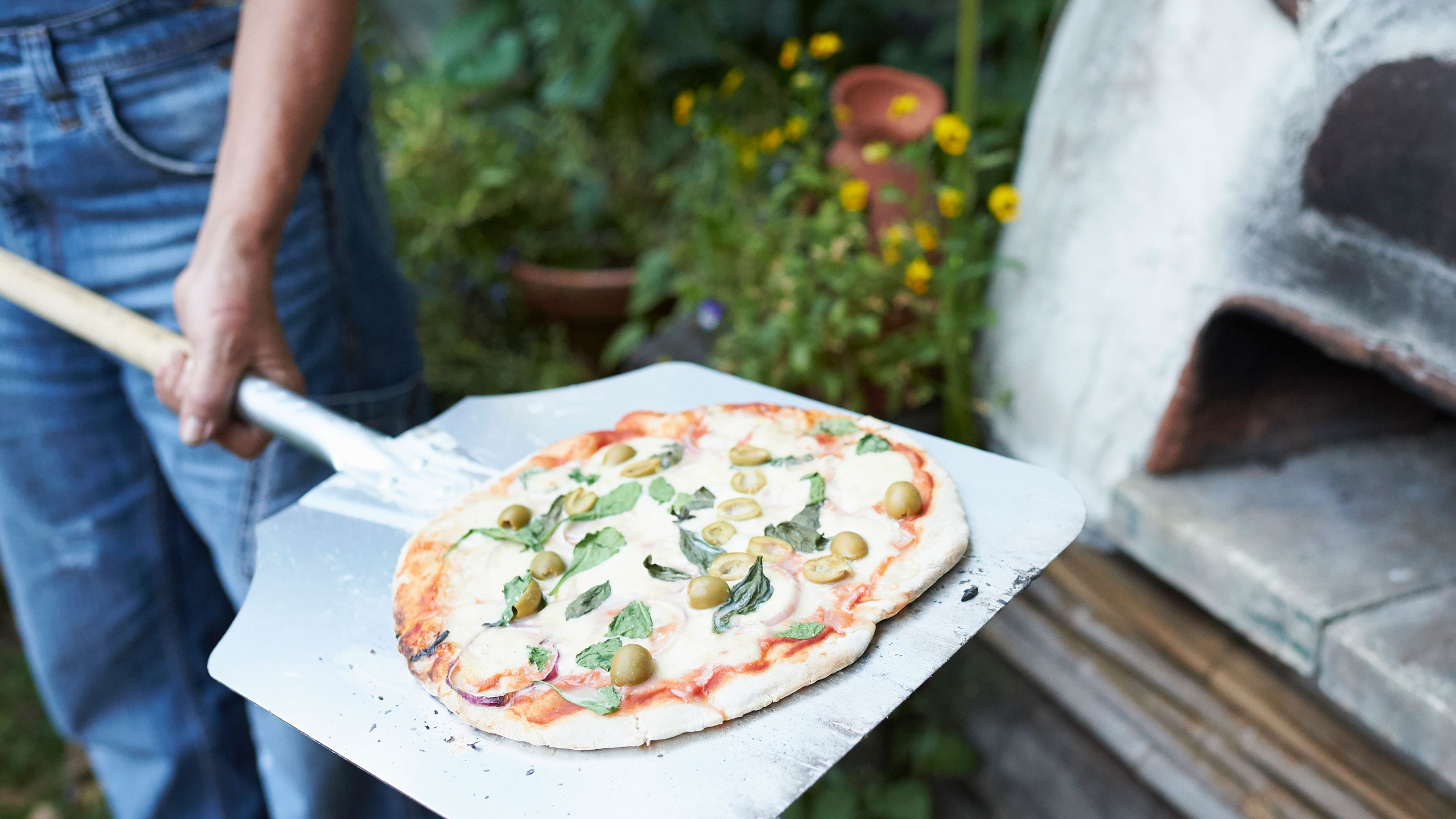How to build a pizza oven - expert DIY advice to make wood-fired pizza outdoors
Wondering how to build a pizza oven at home? It can be easier than you think, especially with these expert tips


Been wondering how to build a pizza oven? As the weather gradually gets warmer and then the sun makes a more frequent appearance in our gardens, you may start thinking more about how to make the most of your outdoor space.
If you enjoy cooking, then having one of the best pizza ovens is a great way to embrace the great outdoors, whilst also providing an excellent alternative to barbecues, for those keen on hosting and dining outside together with friends and family.
While you can get your hands on smaller indoor pizza ovens, if you want a more permanent outdoor fixture, then you’ll need to know how to build a pizza oven. We asked an expert to give their tips and tricks for creating the perfect at-home pizza oven.
How to build a pizza oven
Building a pizza oven from scratch may sound like a pretty tricky task, but with enough research and a little time and dedication, it can be a really rewarding DIY project that yields delicious results.
We've got some tips from Robert Quinton, DIY expert and owner of Construction Megastore, that will break the process down to an easy-to-follow, step-by-step guide. His tips will show you the simplest foolproof method to build your own pizza oven, and we've also included some suggestions of more budget-friendly alternatives if you don't fancy doing too much DIY.
As you'd expect, the first step is to gather any outdoor kitchen ideas you may have, survey your outdoor space, find the spot where you want to build your pizza oven and research all the tools and materials you'll need. This is a task that'll take some time, so ideally you would dedicate a free weekend or a good chunk of time from your week to crafting your pizza oven.
What you will need to build a pizza oven
- Refractory bricks like these from Amazon or clay bricks (for the oven chamber)
- Concrete mix or fireproof mortar like this Bostik Cementone from B&Q
- Fire bricks (for the oven floor)
- Metal stand or concrete base like the Vitcas concrete plinth from Amazon (optional, for elevating the oven)
- Insulating materials such as ceramic fibre blanket like this one from Amazon or pick up this vermiculite/perlite mix from Amazon
- Metal mesh or chicken wire from Amazon (for reinforcement)
- Sand like this fire sand from Screwfix
- Wood for the fire
- A pizza peel like this one from Lakeland (to slide pizzas in and out of the oven)
Step-by-step guide

1. Design and Planning
Robert's first tip is 'to begin the process of building your own pizza oven by deciding on the size and shape you want to create.'
Sign up to our newsletter for style inspiration, real homes, project and garden advice and shopping know-how
'You can find various designs online for inspiration, ranging from simple dome-shaped ovens to more elaborate constructions.'
'Consider the space available in your garden, your skillset, and how many pizzas you intend to make at once to determine the ideal size for your oven.'
Have a look at these pizza oven stand ideas too.
2. Constructing the Base
Robert advises that 'if you opt for a stand or base, start by building this structure using bricks, concrete blocks, or a metal frame, and ensure the base is level and sturdy enough to support the weight of the oven.'

Always use something strong and sturdy like bricks if you are building a base for your pizza oven to stand on.
3. Building the Oven Chamber
If building a classic dome-shaped pizza oven, Robert suggests: 'Using your chosen refractory or clay bricks, construct the dome-shaped oven chamber. Lay the bricks in a circular pattern, gradually building upwards to form the dome, and crucially, remember to leave an opening at the front for the entrance to the oven!'
This method may require some bricklaying skills but don't worry if that sounds too tasking, we've asked another expert for less DIY-intensive options; read on to hear her alternatives.
4. Creating the Oven Floor
Robert continues: 'For the oven floor, lay fire bricks on a bed of fireproof mortar or sand. Ensure the bricks are level and tightly packed together to provide a solid cooking surface.'
5. Insulating the Oven
'To guarantee optimal heat retention and efficiency, insulate the oven chamber with a layer of insulating material.'
Robert suggests, 'Ceramic fibre blanket or a mix of vermiculite and perlite can work well for this purpose, and apply the insulation around the outside of the oven chamber, covering it entirely.'
6. Adding a Protective Layer
For the finishing step, Roberts suggests that in order 'to protect the insulation and give your oven a finished look, apply a layer of render or stucco over the insulation, as this layer also helps to seal the oven and prevent heat loss.'
As mentioned, this can give your pizza oven a more professional and less rustic look once finished. Preventing heat loss is paramount for maintaining a nice even temperature throughout your pizza oven, so that your pizzas cook through evenly without burning around the edges or just on one side.
Alternatives to a DIY pizza oven
And if you don’t feel like building at all, then Caroline Morris, Sales and Business Development Director of Bar-Be-Quick, offers this handy solution:
'If you can’t quite get yourself into the building spirit to muster up creating your own pizza oven, there are some great affordable alternatives to buy on the market. The Bar-Be-Quick Charcoal Pizza Kettle Barbecue available at Amazon is a great way to cook your pizzas outdoors without the hefty price tag of getting all the tools and materials to build it yourself.'
This could be the perfect solution if you’d love a pizza oven but don’t want to commit to a heavy, built-in brick version that can’t be moved around your outdoor space.
She also adds: 'But, if you do want to give some DIY a go, the Build In Grill&Bake with Oven is a great alternative, as you can build all the brickwork, but all the cooking components are ready to slot into place.'
So even if you don't want the faff of building a pizza oven from scratch, there are some good alternatives available that will save you some time and effort, but will still give you great results that allow you to make pizza outdoors.

FAQs
Is it safe to build your own pizza oven at home?
Yes, if proper safety precautions are followed. However you decide to build your pizza oven, always make sure you're wearing the right protective equipment, like gloves and eye protection.
Before you start, it's a good idea to watch and follow the guidance of a video tutorial closely. Always do your research before building, or even call in a professional to ensure that where you have chosen to build the pizza oven is in a safe spot.
What else can a pizza oven be used for?
Pizza ovens can be surprisingly versatile, and their use doesn’t have to be limited to just making pizza.
Consider making different types of bread like naan, flatbreads, etc. Or even slow-cooking meats; a pizza oven maintains a nice even temperature throughout and stays hot for a while afterwards.

After graduating from Durham University in 2020, Olivia studied Modern Languages & Cultures, specifically French and German. Whilst at university, Olivia wrote reviews of student theatre pieces for various university publications, as well as writing voluntarily for a digital magazine during the pandemic. It was during this time that she discovered her love of writing reviews, mainly because she enjoys creating content that is helpful and informative for other readers.